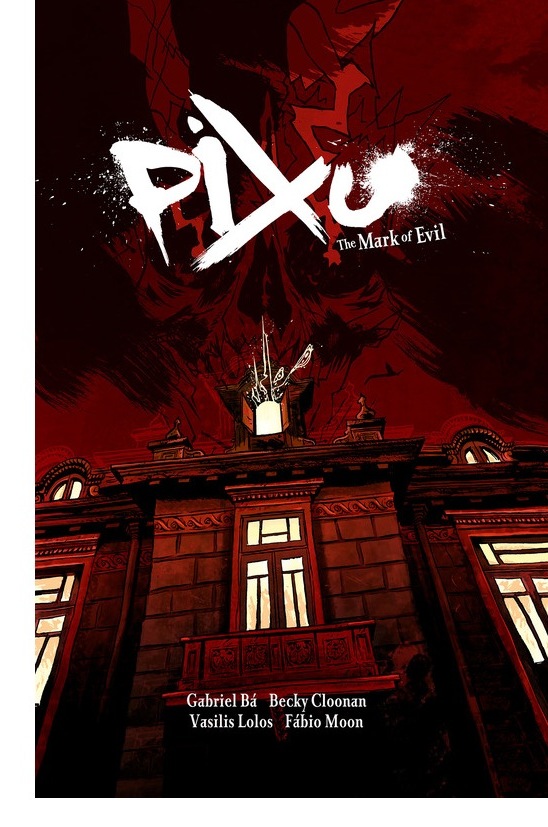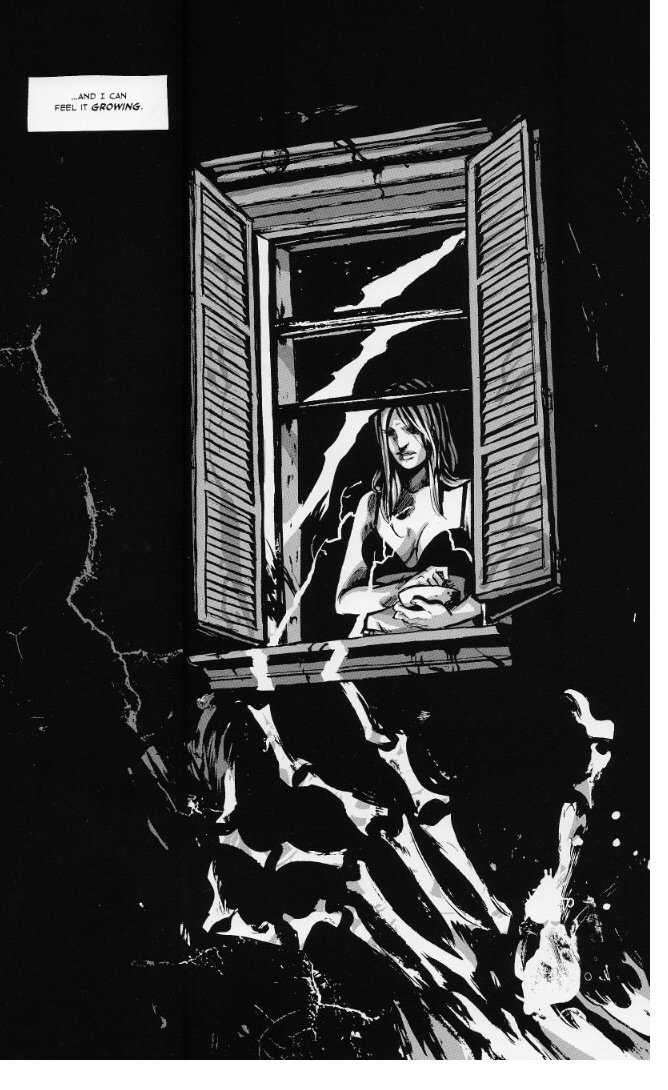
I found myself nodding quite often as I paged through Pixu: The Mark of Evil under the glow of my Buzz Lightyear flashlight. We’ve all got some skeleton or other stashed away in our closets, wire hangers tangled in their rib cages. Who among us doesn’t keep mason jars of deceased chickens in an effort to ward off the juju? Well, regardless of your methods of staving off the encroaching brambles of fear and despair, I’m sure you’ll find something to add to your list of phobias by the time you finish this volume.
Pixu tells the story of a stately and spooky apartment building whose reclusive tenants are doing their best to keep from going absolutely mental. Spoiler alert, none of them are doing a very good job of it and typically end up eating hair or murdering someone. The term Pixu itself refers to a mark that forecasts grim tidings for any who look upon it. I know it only too well. In this story, the mark manifests as a mass of scribbles creeping through windows like a light and shadow take on The Plant That Ate Dirty Socks. There are other elements of the macabre, but the creators made the very wise decision of leaving such aberrations up to interpretation. Where do the mark and its effects stem from? Within or without? Are these tangible elements of the occult or are the tenants themselves going mad? Or maybe we, the readers, are losing it because the book is, in fact, haunted. As someone who recently acquired a bag of old National Geographics, such possibilities are readily on my mind.
Let’s talk about those creators. The contributors include Gabriel Ba, Becky Cloonan, Vasilis Lolos and Fabio Moon. Pixu is an anthology that isn’t. All four creators wrote and illustrated the story marathon style, taking the torch for a length and then passing it on to the next person. While they each focused primarily on specific character threads, they often mingled with each other as the tenants’ stories began to intersect. Individual styles are showcased, but given the consistent visual tone, it’s evident that the artists riffed on each other. These four work really well together, synchronized into a truly beautiful, truly chilling singular vision.
 I don’t know that comics can match film for the complete horror experience. Audio and pacing play a major role in developing atmosphere, and while you can direct pacing in some way through comics, the medium is limited in its capacity for immersion. Film dictates the progression of time completely. You’re trapped. When you’re reading, the ratio shifts and you have more control. Fear is about powerlessness and the inability to understand or control your circumstances. In that way, comics are at a disadvantage. That said, Pixu makes a valiant attempt at relieving you of your bejesus. The creators have a keen understanding of their medium and use all the techniques at their disposal to heighten the tension. Aside from the obvious methods of casting deep shadows, they focus on absurd juxtapositions. Fingernails in your soup? Taking a page from Japanese horror, they highlight the mundane. A phone can be spooky. Architecture can be foreboding. Dialogue is limited so that the emphasis is always on those still images. The book is filled with a tangible sense of loneliness and silence, horror hallmarks because they’re so easily broken.
I don’t know that comics can match film for the complete horror experience. Audio and pacing play a major role in developing atmosphere, and while you can direct pacing in some way through comics, the medium is limited in its capacity for immersion. Film dictates the progression of time completely. You’re trapped. When you’re reading, the ratio shifts and you have more control. Fear is about powerlessness and the inability to understand or control your circumstances. In that way, comics are at a disadvantage. That said, Pixu makes a valiant attempt at relieving you of your bejesus. The creators have a keen understanding of their medium and use all the techniques at their disposal to heighten the tension. Aside from the obvious methods of casting deep shadows, they focus on absurd juxtapositions. Fingernails in your soup? Taking a page from Japanese horror, they highlight the mundane. A phone can be spooky. Architecture can be foreboding. Dialogue is limited so that the emphasis is always on those still images. The book is filled with a tangible sense of loneliness and silence, horror hallmarks because they’re so easily broken.
What I find most chilling about this story or this tangle of stories is the level of mystery. There are clues scattered throughout these pages that will satisfy various plot threads, but much is left for the audience to sort out. Explaining the root of a scare is effectively castrating its demons. Knowledge is power, and that is the last thing you want with this kind of experience. Horror ought to stick to your ribs, nag at you for the hours and days to follow. Pixu is gonna bother me for a good long time. I hope it bothers you too.
Paul Montgomery was born in a Walgreens over an ancient Indian burial ground. Ironically, it happened in the greeting cards section, in front of the ‘sympathy’ rack. Find him on Twitter or contact him at paul@ifanboy.com.


Setting the scary mood in comics is a whole different ballgame than in movies. Like you said, while reading, you dictate the time progressing, so cheap "boo" scares won’t work. The writer and artist have to set the mood with a creepy image that you cant pry your eyes away from. From the sound of it, this book does a great job with it, so I’ll definitely be picking it up!
awesome article Paul. i really hope my LCS has this. i could use a good horror story right now.
Nice review, Paul. I agree with the assessment. I read this recently, and all the contributors definitely do a great job of using visuals and small moments to build dread. That said, as a story, I did find myself a little lost in the narrative. I still felt what I was supposed to feel, but there were a couple of times I was pulled out of the story, scratching my head for a brief moment to ask, "now, who did…? and what…?"
BTW, your last line makes for a a great quote. I hope to see that on future editions of Pixu, if anyone at Dark Horse happens to be paying attention… 😉
I foresee buying this and reading it on Halloween between the time the kids stop showing up at my door and when I pass out from sugar overdose. It should make for some interesting sugar fever induced nightmares.
I find that horror comics don’t really do much for me. Maybe that’s why I’m in the minority in not really liking LOCKE & KEY. The only horror comic that’s ever really worked for me on a visceral level was the manga GYO. That creeped me out.
Still, I wouldn’t mind checking this one out. Well written review, Paul.
Thanks for the review, Paul. I was leaning toward picking this up based on the strength of the creators, and this review solidified it.
This sounds very cool! Awesome review.
this looks really cool. and scary. looks like a good xmas present for my horror loving but non comic reading sister =)